Abstract
The pathophysiology of delayed cerebral ischemia (DCI) after aneurysmal subarachnoid hemorrhage (aSAH) is incompletely understood. Intrathecal activation of inflammatory immune cells is suspected to play a major role for the induction of DCI. The aim of this study is to identify immune cell subsets and mediators involved in the pathogenesis of DCI. We prospectively collected blood and CSF from 25 patients with aSAH at early and late time points. We performed multicolor flow cytometry of peripheral blood and CSF, analyzing immune cell activation and pro-inflammatory cyto- and chemokines. In addition to the primary immune analysis, we retrospectively analyzed immune cell dynamics in the CSF of all our SAH patients. Our results show an increased monocyte infiltration secondary to aneurysm rupture in patients with DCI. Infiltrating monocytes are defined by a non-classical (CD14dim CD16+) phenotype at early stages. The infiltration is most likely triggered by the intrathecal immune activation. Here, high levels of pro-inflammatory chemokines, such as CXCL1, CXCL9, CXCL10, and CXCL11, are detected. The intrathecal cellular activation profile of monocytes was defined by upregulation of CD163 and CD86 on monocytes and a presumable later differentiation into antigen-presenting plasmacytoid dendritic cells (pDCs) and hemosiderophages. Peripheral immune activation was reflected by CD69 upregulation on T cells. Analysis of DCI prevalence, Hunt and Hess grade, and clinical outcome correlated with the degree of immune activation. We demonstrate that monocytes and T cells are activated intrathecally after aSAH and mediate a local inflammatory response which is presumably driven by chemokines. Our data shows that the distinct pattern of immune activation correlates with the prevalence of DCI, indicating a pathophysiological connection to the incidence of vasospasm.






Similar content being viewed by others
Abbreviations
- aSAH:
-
aneurysmal subarachnoid hemorrhage
- CD:
-
cluster of differentiation
- CSF:
-
cerebrospinal fluid
- DCI:
-
delayed cerebral ischemia
- H&H:
-
Hunt and Hess grading
- IL:
-
interleukin
- mDC:
-
myeloid dendritic cell
- mRS:
-
modified Rankin scale
- PBMCs:
-
peripheral blood mononuclear cells
- pDC:
-
plasmacytoid dendritic cell
- SAH:
-
subarachnoid hemorrhage
- Treg :
-
regulatory T cells
References
Etminan N, Chang H-S, Hackenberg K, de Rooij NK, Vergouwen MDI, Rinkel GJE, et al. Worldwide incidence of aneurysmal subarachnoid hemorrhage according to region, time period, blood pressure, and smoking prevalence in the population: a systematic review and meta-analysis. JAMA Neurol [Internet]. 2019; Available from: http://www.ncbi.nlm.nih.gov/pubmed/30659573.
Darkwah Oppong M, Buffen K, Pierscianek D, Herten A, Ahmadipour Y, Dammann P, et al. Secondary hemorrhagic complications in aneurysmal subarachnoid hemorrhage: when the impact hits hard. J Neurosurg [Internet]. 2019;1–8. Available from: http://www.ncbi.nlm.nih.gov/pubmed/30684947.
Etminan N, Macdonald RL. Management of aneurysmal subarachnoid hemorrhage. Handb Clin Neurol [Internet]. 2017;140:195–228. Available from: http://www.ncbi.nlm.nih.gov/pubmed/28187800.
Lawton MT, Vates GE. Subarachnoid hemorrhage. N Engl J Med [Internet]. 2017;377:257–66. Available from: http://www.ncbi.nlm.nih.gov/pubmed/28723321.
Foreman B. The pathophysiology of delayed cerebral ischemia. J Clin Neurophysiol [Internet]. 2016;33:174–82. Available from: http://www.ncbi.nlm.nih.gov/pubmed/27258440.
Geraghty JR, Testai FD. Delayed cerebral ischemia after subarachnoid hemorrhage: beyond vasospasm and towards a multifactorial pathophysiology. Curr Atheroscler Rep [Internet]. 2017;19:50. Available from: http://www.ncbi.nlm.nih.gov/pubmed/29063300.
Ciurea AV, Palade C, Voinescu D, Nica D a. Subarachnoid hemorrhage and cerebral vasospasm-literature review. J Med Life [Internet]. 2013;6:120–5. Available from: http://www.pubmedcentral.nih.gov/articlerender.fcgi?artid=3725434&tool=pmcentrez&rendertype=abstract
Dumont AS, Dumont RJ, Chow MM, Lin C-L, Calisaneller T, Ley KF, et al. Cerebral vasospasm after subarachnoid hemorrhage: putative role of inflammation. Neurosurgery. 2003;53:123–33 discussion 133-135.
Neil-Dwyer G, Cruickshank J. The blood leucocyte count and its prognostic significance in subarachnoid haemorrhage. Brain. 1974;97:79–86.
McGirt MJ, Mavropoulos JC, McGirt LY, Alexander MJ, Friedman AH, Laskowitz DT, et al. Leukocytosis as an independent risk factor for cerebral vasospasm following aneurysmal subarachnoid hemorrhage. J Neurosurg. 2003;98:1222–6.
Vecchione C, Frati A, Di Pardo A, Cifelli G, Carnevale D, Gentile MT, et al. Tumor necrosis factor-?? Mediates hemolysis-induced vasoconstriction and the cerebral vasospasm evoked by subarachnoid hemorrhage. Hypertension. 2009;54:150–6.
Provencio JJ. Inflammation in subarachnoid hemorrhage and delayed deterioration associated with vasospasm: s review. Acta Neurochir Suppl. 2013. p. 233–8.
Miller BA, Turan N, Chau M, Pradilla G. Inflammation, vasospasm, and brain injury after subarachnoid hemorrhage. Int: Biomed Res; 2014.
Gaetani P, Tartara F, Pignatti P, Tancioni F, Rodriguez y Baena R, De Benedetti F. Cisternal CSF levels of cytokines after subarachnoid hemorrhage. Neurol Res 1998;20:337–342.
Provencio JJ, Fu X, Siu A, Rasmussen PA, Hazen SL, Ransohoff RM. CSF neutrophils are implicated in the development of vasospasm in subarachnoid hemorrhage. Neurocrit Care [Internet]. 2010;12:244–51. Available from: http://www.ncbi.nlm.nih.gov/pubmed/19967568.
Hunt WE, Hess RM. Surgical risk as related to time of intervention in the repair of intracranial aneurysms. J Neurosurg [Internet]. 1968;28:14–20. Available from: http://www.ncbi.nlm.nih.gov/pubmed/5635959.
Vergouwen MDI, Vermeulen M, van Gijn J, Rinkel GJE, Wijdicks EF, Muizelaar JP, et al. Definition of delayed cerebral ischemia after aneurysmal subarachnoid hemorrhage as an outcome event in clinical trials and observational studies. Stroke [Internet]. 2010;41:2391–5. Available from: https://www.ahajournals.org/doi/10.1161/STROKEAHA.110.589275
Charo IF, Ransohoff RM. The many roles of chemokines and chemokine receptors in inflammation. N Engl J Med [Internet]. 2006;354:610–21. Available from: http://www.ncbi.nlm.nih.gov/pubmed/16467548.
Ziegler-Heitbrock L. Monocyte subsets in man and other species. Cell Immunol [Internet]. 289:135–9. Available from: http://www.ncbi.nlm.nih.gov/pubmed/24791698.
Buscher K, Marcovecchio P, Hedrick CC, Ley K. Patrolling mechanics of non-classical monocytes in vascular inflammation. Front Cardiovasc Med [Internet]. 2017;4. Available from: http://journal.frontiersin.org/article/10.3389/fcvm.2017.00080/full
Zheng VZ, Wong GKC. Neuroinflammation responses after subarachnoid hemorrhage: a review. J Clin Neurosci [Internet]. 2017;42:7–11. Available from: http://www.ncbi.nlm.nih.gov/pubmed/28302352.
Sarrafzadeh A, Schlenk F, Meisel A, Dreier J, Vajkoczy P, Meisel C. Immunodepression after aneurysmal subarachnoid hemorrhage. Stroke. 2011;42:53–8.
Jedrzejowska-Szypułka H, Straszak G, Larysz-Brysz M, Karpe J, Marcol W, Olakowska E, et al. Interleukin-1beta plays a role in the activation of peripheral leukocytes after blood-brain barrier rupture in the course of subarachnoid hemorrhage. Curr Neurovasc Res [Internet]. 2010;7:39–48. Available from: http://www.ncbi.nlm.nih.gov/pubmed/20158463.
Chrapusta SJ, Górski A, Mrowiec T, Grieb P, Andrychowski J, Ryba MS. Immune abnormalities in aneurysmal subarachnoid haemorrhage patients: relation to delayed cerebral vasospasm. Scand J Immunol [Internet]. 2000;51:400–7. Available from: http://www.ncbi.nlm.nih.gov/pubmed/10736113.
Niwa A, Osuka K, Nakura T, Matsuo N, Watabe T, Takayasu M. Interleukin-6, MCP-1, IP-10, and MIG are sequentially expressed in cerebrospinal fluid after subarachnoid hemorrhage. J Neuroinflammation [Internet]. 2016;13:217. Available from: http://www.ncbi.nlm.nih.gov/pubmed/27576738.
Che X, Ye W, Panga L, Wu DC, Yang GY. Monocyte chemoattractant protein-1 expressed in neurons and astrocytes during focal ischemia in mice. Brain Res [Internet]. 2001;902:171–7. Available from: http://www.ncbi.nlm.nih.gov/pubmed/11384610.
Chu HX, Arumugam T V, Gelderblom M, Magnus T, Drummond GR, Sobey CG. Role of CCR2 in inflammatory conditions of the central nervous system. J Cereb Blood Flow Metab [Internet]. 2014;34:1425–9. Available from: http://www.ncbi.nlm.nih.gov/pubmed/24984897.
Duan L, Zhang X-D, Miao W-Y, Sun Y-J, Xiong G, Wu Q, et al. PDGFRβ cells rapidly relay inflammatory signal from the circulatory system to neurons via chemokine CCL2. Neuron [Internet]. 2018;100:183-200.e8. Available from: http://www.ncbi.nlm.nih.gov/pubmed/30269986.
Roberts TK, Eugenin EA, Lopez L, Romero IA, Weksler BB, Couraud P-O, et al. CCL2 disrupts the adherens junction: implications for neuroinflammation. Lab Invest [Internet]. 2012;92:1213–33. Available from: http://www.ncbi.nlm.nih.gov/pubmed/22641100.
Lu H, Shi J-X, Chen H-L, Hang C-H, Wang H-D, Yin H-X. Expression of monocyte chemoattractant protein-1 in the cerebral artery after experimental subarachnoid hemorrhage. Brain Res [Internet]. 2009;1262:73–80. Available from: http://www.ncbi.nlm.nih.gov/pubmed/19401162.
Kim GH, Kellner CP, Hahn DK, Desantis BM, Musabbir M, Starke RM, et al. Monocyte chemoattractant protein-1 predicts outcome and vasospasm following aneurysmal subarachnoid hemorrhage. J Neurosurg [Internet]. 2008;109:38–43. Available from: http://www.ncbi.nlm.nih.gov/pubmed/18593272.
Corbera-Bellalta M, Planas-Rigol E, Lozano E, Terrades-García N, Alba MA, Prieto-González S, et al. Blocking interferon γ reduces expression of chemokines CXCL9, CXCL10 and CXCL11 and decreases macrophage infiltration in ex vivo cultured arteries from patients with giant cell arteritis. Ann Rheum Dis [Internet]. 2016;75:1177–86. Available from: http://www.ncbi.nlm.nih.gov/pubmed/26698852.
Kubota T, Handa Y, Tsuchida a., Kaneko M, Kobayashi H. The kinetics of lymphocyte subsets and macrophages in subarachnoid space after subarachnoid hemorrhage in rats. Stroke [Internet]. 1993 [cited 2014 Nov 1];24:1993–2000. Available from: http://stroke.ahajournals.org/cgi/doi/10.1161/01.STR.24.12.1993
Aihara Y, Kasuya H, Onda H, Hori T, Takeda J, Faraci FM. Quantitative analysis of gene expressions related to inflammation in canine spastic artery after subarachnoid hemorrhage editorial comment. Stroke [Internet]. 2001 [cited 2014 Oct 22];32:212–7. Available from: http://stroke.ahajournals.org/cgi/doi/10.1161/01.STR.32.1.212
Hughes JT, Schianchi PM. Cerebral artery spasm. A histological study at necropsy of the blood vessels in cases of subarachnoid hemorrhage. J Neurosurg [Internet]. 1978;48:515–25. Available from: http://www.ncbi.nlm.nih.gov/pubmed/632876.
Dzenko KA, Song L, Ge S, Kuziel WA, Pachter JS. CCR2 expression by brain microvascular endothelial cells is critical for macrophage transendothelial migration in response to CCL2. Microvasc Res [Internet]. 2005;70:53–64. Available from: http://www.ncbi.nlm.nih.gov/pubmed/15927208.
Anbazhagan K, Duroux-Richard I, Jorgensen C, Apparailly F. Transcriptomic network support distinct roles of classical and non-classical monocytes in human. Int Rev Immunol [Internet]. 33:470–89. Available from: http://www.ncbi.nlm.nih.gov/pubmed/24730730.
Zimmermann HW, Seidler S, Nattermann J, Gassler N, Hellerbrand C, Zernecke A, et al. Functional contribution of elevated circulating and hepatic non-classical CD14CD16 monocytes to inflammation and human liver fibrosis. PLoS One [Internet]. 2010;5:e11049. Available from: http://www.ncbi.nlm.nih.gov/pubmed/20548789.
Wypasek E, Padjas A, Szymańska M, Plens K, Siedlar M, Undas A. Non-classical and intermediate monocytes in patients following venous thromboembolism: links with inflammation. Adv Clin Exp Med [Internet]. 2019;28:51–8. Available from: http://www.ncbi.nlm.nih.gov/pubmed/30088349.
Puchner A, Saferding V, Bonelli M, Mikami Y, Hofmann M, Brunner JS, et al. Non-classical monocytes as mediators of tissue destruction in arthritis. Ann Rheum Dis [Internet]. 2018;77:1490–7. Available from: http://www.ncbi.nlm.nih.gov/pubmed/29959183.
Bharat A, McQuattie-Pimentel AC, Budinger GRS. Non-classical monocytes in tissue injury and cancer. Oncotarget [Internet]. 2017;8:106171–2. Available from: http://www.ncbi.nlm.nih.gov/pubmed/29290937.
Ong S-M, Hadadi E, Dang T-M, Yeap W-H, Tan CT-Y, Ng T-P, et al. The pro-inflammatory phenotype of the human non-classical monocyte subset is attributed to senescence. Cell Death Dis [Internet]. 2018;9:266. Available from: http://www.ncbi.nlm.nih.gov/pubmed/29449647.
Mukherjee R, Kanti Barman P, Kumar Thatoi P, Tripathy R, Kumar Das B, Ravindran B. Non-classical monocytes display inflammatory features: validation in sepsis and systemic lupus erythematous. Sci Rep [Internet]. 2015;5:13886. Available from: http://www.ncbi.nlm.nih.gov/pubmed/26358827.
Shimizu K, Kushamae M, Mizutani T, Aoki T. Intracranial aneurysm as a macrophage-mediated inflammatory disease. Neurol Med Chir (Tokyo) [Internet]. 2019; Available from: http://www.ncbi.nlm.nih.gov/pubmed/30867357.
Provencio JJ, Altay T, Smithason S, Moore SK, Ransohoff RM. Depletion of Ly6G/C(+) cells ameliorates delayed cerebral vasospasm in subarachnoid hemorrhage. J Neuroimmunol [Internet]. 2011;232:94–100. Available from: http://www.ncbi.nlm.nih.gov/pubmed/21059474.
Etzerodt A, Moestrup SK. CD163 and inflammation: biological, diagnostic, and therapeutic aspects. Antioxid Redox Signal [Internet]. 2013;18:2352–63. Available from: http://www.ncbi.nlm.nih.gov/pubmed/22900885.
Guo L, Akahori H, Harari E, Smith SL, Polavarapu R, Karmali V, et al. CD163+ macrophages promote angiogenesis and vascular permeability accompanied by inflammation in atherosclerosis. J Clin Invest [Internet]. 2018;128:1106–24. Available from: http://www.ncbi.nlm.nih.gov/pubmed/29457790.
Acknowledgments
We thank all patients and relatives for their support and participation in this study. We thank Sabine Wuttke for her excellent graphical support. Our study would not be possible without the excellent technical support of Manuela Kolster, Mareike Holz, Katharina Kolbe, Svenja Zapf, Sarah Matulla, and the FACS Core Facility at UKE.
Author information
Authors and Affiliations
Corresponding author
Ethics declarations
Conflict of Interest
The authors declare that they have no conflict of interest.
Ethical Approval
All procedures performed in studies involving human participants were in accordance with the ethical standards of the institutional and/or national research committee (Hamburger Ärztekammer, PV5106) and with the 1964 Helsinki declaration and its later amendments or comparable ethical standards.
Additional information
Publisher’s Note
Springer Nature remains neutral with regard to jurisdictional claims in published maps and institutional affiliations.
Rights and permissions
About this article
Cite this article
Mohme, M., Sauvigny, T., Mader, M.MD. et al. Immune Characterization in Aneurysmal Subarachnoid Hemorrhage Reveals Distinct Monocytic Activation and Chemokine Patterns. Transl. Stroke Res. 11, 1348–1361 (2020). https://doi.org/10.1007/s12975-019-00764-1
Received:
Revised:
Accepted:
Published:
Issue Date:
DOI: https://doi.org/10.1007/s12975-019-00764-1




